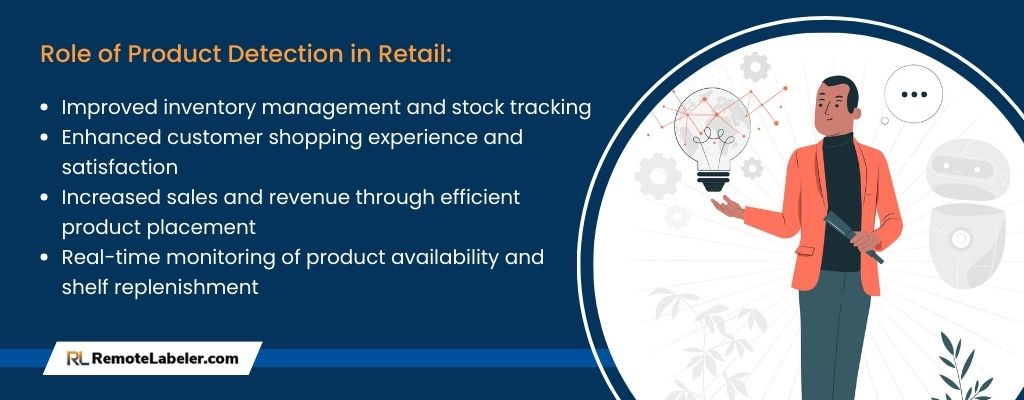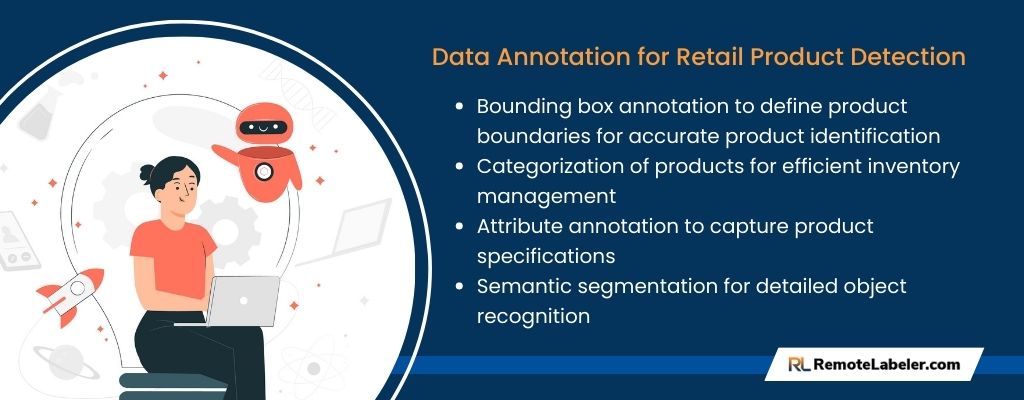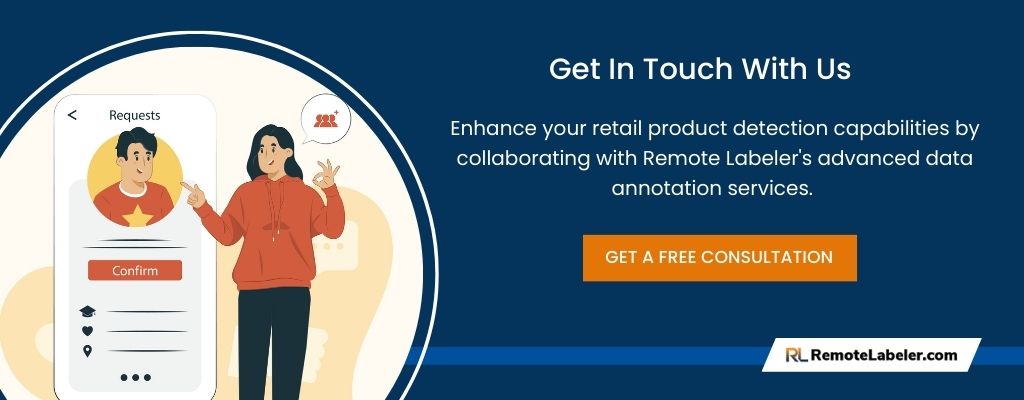In the dynamic and ever-evolving landscape of the retail industry, product detection plays a pivotal role in shaping its success. From efficient inventory management to seamless customer experiences, and optimizing supply chain operations, the ability to accurately identify and recognize products is paramount. In this context, data annotation emerges as a key enabler, facilitating the training of advanced machine learning models that power product detection systems. This article delves deep into the potential of outsource retail data annotation and explores the transformative impact it holds for enhancing product detection within the retail sector.
At the heart of modern retail, data annotation serves as the backbone of artificial intelligence applications. It involves the meticulous process of labeling and tagging vast amounts of data, making it comprehensible for machine learning algorithms. These algorithms, driven by computer vision, can then autonomously identify and classify various products from images or videos, transforming retail operations and customer experiences. Properly annotated datasets ensure the accuracy and reliability of machine learning models, minimizing errors and elevating the overall performance of product detection systems. As the retail industry continues to embrace the digital revolution, data annotation for ecommerce and retail object detection datasets has become a critical driver of success for businesses seeking a competitive edge.
In the dynamic landscape of the retail industry, product detection holds immense significance for enhancing various aspects of the business, including inventory management, customer experience, and supply chain optimization. In an era where data-driven decisions reign supreme, leveraging advanced technologies like outsource data labeling for retail product detection becomes crucial. This article explores the ins and outs of data annotation in the retail domain, delving into its importance and the advantages of outsourcing such processes to specialized service providers like Remote Labeler.
Understanding Product Detection in Retail
Product detection in the retail industry is a revolutionary technology that leverages computer vision and machine learning algorithms to automatically identify and recognize products in various settings. This cutting-edge capability has revolutionized the way retailers manage their operations and interact with customers. By harnessing the power of data annotation for retail product detection, businesses can achieve unprecedented levels of accuracy, efficiency, and customer satisfaction.

1. Real-time Inventory Management
One of the most significant benefits of product detection in retail is its impact on real-time inventory management. With precise and reliable product detection systems in place, retailers can effortlessly track the movement of products on their shelves. This real-time monitoring enables them to maintain optimal stock levels, avoid stockouts, and efficiently restock items as needed. As a result, retailers can optimize their inventory management processes, reducing carrying costs and minimizing waste.
2. Enhanced Customer Experiences
Product detection also plays a crucial role in enhancing customer experiences both in physical retail stores and online shopping platforms. In brick-and-mortar stores, product detection technology can be integrated with interactive displays, smart shelves, and touch-screen kiosks, providing shoppers with instant access to product information, pricing, and availability. In the realm of e-commerce, product detection enables personalized product recommendations, allowing customers to discover relevant items easily. This level of personalization and convenience fosters customer loyalty and increases the likelihood of repeat purchases.
3. Streamlined Supply Chain Optimization
A well-implemented product detection system can significantly streamline the supply chain in the retail industry. By accurately predicting demand patterns and identifying popular products, retailers can optimize their supply chain operations, ensuring the right products are available at the right locations and times. This optimization reduces unnecessary transportation costs, minimizes inventory holding expenses, and ultimately leads to a more efficient and cost-effective supply chain.
4. Preventing Retail Theft and Fraud
Product detection technology also aids in preventing retail theft and fraud. By implementing surveillance systems equipped with product detection capabilities, retailers can monitor store activities and promptly detect any suspicious behavior or unauthorized removal of items from shelves. This proactive approach helps reduce shrinkage and protects the bottom line of retail businesses.
The Importance of Data Annotation for Retail Product Detection
In the realm of retail product detection, data annotation emerges as a foundational pillar, underpinning the success of modern AI-powered systems. As retailers strive to keep up with ever-changing consumer demands and market trends, the accurate identification of products becomes paramount for various operational aspects. Here’s why data annotation is of utmost importance in retail:
- Enhanced Product Classification: In the vast array of products available in retail stores or e-commerce platforms, accurate classification is crucial for streamlined inventory management. Data annotation enables machine learning models to distinguish between different products, categorizing them into specific groups, which in turn simplifies stock tracking and replenishment processes. Retailers can optimize shelf space, stock the right products, and prevent stockouts or overstock situations, leading to better profitability and customer satisfaction.
- Seamless Customer Experiences: Today’s tech-savvy consumers demand frictionless shopping experiences. Data annotation empowers retailers to deploy cutting-edge product detection systems that can instantly recognize items, leading to faster checkouts and reduced wait times. Whether through cashier-less checkout lanes or automated mobile shopping applications, these seamless experiences contribute to increased customer loyalty and higher customer retention rates.
- Supply Chain Optimization: Retailers grappling with complex supply chains can benefit significantly from data annotation. By accurately tracking and identifying products along the supply chain, from manufacturers to distribution centers and retail outlets, data annotation helps streamline logistics and inventory management. Retailers gain real-time visibility into product movement, allowing them to identify bottlenecks, optimize routes, and make data-driven decisions for efficient supply chain operations.
- Personalized Marketing and Recommendations: Data annotation also plays a vital role in gathering valuable customer insights. By effectively labeling product attributes, such as color, size, brand, and material, retailers can better understand consumer preferences and behaviors. This information enables targeted marketing campaigns and personalized product recommendations, thereby increasing the likelihood of conversion and customer satisfaction.
In essence, data annotation for retail product detection serves as the bedrock upon which advanced technologies like computer vision and machine learning thrive. As the retail landscape continues to evolve, embracing data annotation becomes essential for staying ahead in a highly competitive market, unlocking the full potential of product detection for the benefit of both retailers and customers alike.
Outsource Retail Data Annotation Techniques for Retail Product Detection
To harness the full potential of data annotation for retail product detection, businesses often turn to outsourcing as a strategic approach. Outsourcing data annotation offers a myriad of advantages, including access to specialized expertise, scalability for handling large-scale datasets, cost-effectiveness, and improved time efficiency. Partnering with a reliable and proficient data annotation service provider empowers retailers to leverage cutting-edge techniques, such as semantic segmentation, object detection, instance segmentation, and 3D bounding box annotation. Let’s explore these data annotation techniques and their significance in revolutionizing product detection within the retail sector:

1. Semantic Segmentation
Semantic segmentation stands as a powerful data annotation technique for retail product detection. This method involves the pixel-level annotation of images, where each pixel is meticulously labeled to represent the specific object it belongs to. In the realm of retail, semantic segmentation allows for the creation of precise boundaries around individual items, enabling accurate identification and isolation of products within images. This technique is particularly beneficial for inventory management, as it empowers retailers to track the availability of each product in real-time. With detailed insights into the location and quantity of products on shelves or in storage, retail businesses can optimize their inventory levels, reduce stockouts, and ensure a seamless shopping experience for customers.
2. Object Detection
Another fundamental data annotation technique for retail product detection is object detection. In this method, specific objects within images are labeled and outlined using bounding boxes. By identifying and delineating multiple products present in a single image, object detection is instrumental in automating stock monitoring processes. Retailers can efficiently analyze the movement of products on shelves and assess consumer preferences, thereby enabling data-driven decisions for restocking and merchandising strategies. Additionally, this technique is essential for accurate product categorization and pricing, leading to improved customer experiences and increased operational efficiency.
3. Instance Segmentation
Instance segmentation is a more advanced data annotation technique that combines the principles of both semantic segmentation and object detection. It goes beyond mere bounding boxes and provides pixel-level labeling for each instance of an object within an image. In the context of retail product detection, instance segmentation enables the precise identification and tracking of individual products, even when they are in close proximity or partially occluded. As a result, retailers can gain granular insights into product positioning, popularity, and demand, aiding in inventory forecasting and effective assortment planning. Moreover, the enhanced accuracy of instance segmentation contributes to heightened operational efficiency and ultimately improves the overall customer experience.
4. 3D Bounding Box Annotation
For retail stores and e-commerce platforms incorporating 3D visualization features, 3D bounding box annotation becomes imperative. This technique allows the accurate capture of spatial dimensions for each product in an image, facilitating a more immersive and interactive shopping experience for customers. Retailers can virtually present products from various angles, enabling shoppers to inspect items closely before making a purchase. Furthermore, 3D bounding box annotation streamlines inventory and warehouse management, as it aids in optimizing storage space and enhances the accuracy of logistics operations. Embracing 3D visualization through data annotation for retail product detection elevates the engagement level of customers, fostering loyalty and driving conversion rates.
As retail businesses strive to leverage the potential of data annotation for enhanced product detection, these outsource retail data annotation techniques provide a solid foundation for building sophisticated machine learning models. By partnering with experienced and reputable data annotation service providers, retailers can access a pool of expertise in these techniques, ensuring high-quality annotations and accelerated development of efficient product detection systems. The continuous advancement of data annotation for retail promises a future where inventory management, customer experiences, and supply chain optimization seamlessly converge, redefining the retail industry as a whole.
The Advantages of Outsourcing Data Annotation
To achieve seamless and accurate product detection, retailers are increasingly turning to outsource data annotation techniques. These advanced methods of data labeling and tagging are the foundation upon which cutting-edge machine learning models are trained. By collaborating with specialized annotation teams, retailers can leverage the expertise of professionals well-versed in various annotation techniques, ensuring the highest level of precision and performance. Let’s explore some of the key outsource retail data annotation techniques that revolutionize product detection in the retail industry, empowering businesses to optimize their inventory management, deliver exceptional customer experiences, and streamline their supply chain operations.
- Access to Expertise: Retailers gain access to skilled professionals well-versed in various annotation techniques, ensuring superior model performance and high accuracy.
- Scalability and Flexibility: External annotation services handle projects of varying sizes and complexities, adapting to changing annotation demands.
- Cost-Effectiveness: Outsourcing eliminates upfront costs associated with building an in-house team, optimizing ROI for data annotation efforts.
- Time-Efficiency and Faster Deployment: Professional teams expedite the annotation process, accelerating model training and system deployment.
- Focus on Core Competencies: Retailers can concentrate on core business goals while experts handle data annotation tasks.
- Risk Mitigation and Quality Assurance: Established providers ensure data privacy, security, and rigorous quality control for reliable annotations.
By partnering with specialized annotation teams, retailers can leverage expertise, achieve cost-effectiveness, and streamline their core business operations. The advantages of outsourcing data annotation ultimately elevate retail operations and customer experiences, enabling retailers to thrive in the competitive market.

How to Get Started with Remote Labeler
Remote Labeler is a leading data annotation service provider specializing in delivering accurate and comprehensive solutions for retail product detection. With a team of seasoned experts in data annotation techniques and a commitment to excellence, Remote Labeler empowers retailers with the tools and expertise needed to optimize their product detection systems. Leveraging cutting-edge technologies, stringent quality control processes, and a smart approach to data annotation, Remote Labeler is a trusted partner for retailers looking to enhance inventory management, streamline supply chains, and create superior customer experiences.
Partnering with Remote Labeler for your data annotation needs, including biomedical image annotation, is a simple and efficient process that ensures your retail product detection endeavors are met with success. Follow these steps to kickstart your journey towards deploying high-performance machine learning models:
- Submit the Form: Reach out to us using the provided form to request our data annotation services.
- Share Your Project Details: Provide us with the specific details and requirements of your project, including the type of annotation you need and any guidelines or instructions.
- Receive Estimate and Offer: After reviewing your project requirements, we will offer you an estimate of the cost and provide a detailed proposal outlining the scope of our services and the expected timeline for completion.
- Payment and Collaboration: Once you accept our estimate, an invoice will be issued for payment. Upon receipt of payment, we will begin the collaboration, working closely together to fulfill all your data annotation needs.
With Remote Labeler as your data annotation partner, you can rest assured that your retail product detection initiatives are in capable hands. The combination of Remote Labeler’s technical expertise, advanced annotation techniques, and a dedication to delivering high-quality results will propel your retail business to new heights of success. Embrace the power of data annotation for retail and unlock the true potential of product detection in the ever-evolving world of retail.
Conclusion
In the ever-evolving retail landscape, outsource retail data annotation has emerged as a powerful tool for achieving improved product detection. By leveraging techniques such as bounding box annotation and semantic segmentation, retailers can benefit from enhanced accuracy and inventory management, leading to superior customer experiences and optimized supply chain operations. Outsourcing data annotation to experts like Remote Labeler not only ensures access to specialized skills but also offers scalability and cost-effectiveness. Embrace the potential of data annotation for retail product detection and unlock new avenues for success in the competitive retail industry.
To elevate your retail product detection capabilities, partner with Remote Labeler’s cutting-edge data annotation services. Visit our website and get started today!
- Emerging Trends and Future Outlook: The Data Labeling Industry in 2024-2030 - December 8, 2023
- Landmark Annotation: Key Points - November 6, 2023
- All You Should Know About Bounding Box Annotation - November 5, 2023